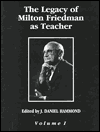Table of Contents
Contents:Acknowledgements • IntroductionVolume I:Part I: Students’ Reflections on their Teacher1. Gerald P. Dwyer, Jr. (1999), ‘How was Milton Friedman Distinctive as a Teacher?’2. David I. Fand (1999), ‘Friedman’s Price Theory: Economics 300 at the University of Chicago in 1947–1951’3. Richard H. Timberlake (1999), ‘Observations on a Constant Teacher by a Graduate Student Emeritus’4. Gary S. Becker (1991), ‘Milton Friedman 1912–’Part II: The Legacy in Students’ Scholarship5. G. Warren Nutter (1969), ‘Growth of Monopoly: 1899–1939’6. E.J. Mishan (1952), ‘Toward a General Theory of Price, Income, and Money’7. William Hamburger (1955), ‘The Relation of Consumption to Wealth and the Wage Rate’8. Phillip Cagan (1956), ‘The Monetary Dynamics of Hyperinflation’9. Eugene M. Lerner (1955), ‘Money, Prices, and Wages in the Confederacy, 1861–65’10. Richard T. Selden (1956), ‘Monetary Velocity in the United States’11. Gary S. Becker (1957), ‘The Forces Determining Discrimination in the Market Place’ and ‘Effective Discrimination’12. John J. Klein (1960), ‘Price-Level and Money-Denomination Movements’13. Norman V. Breckner (1958), ‘Liquidity and Farm Investment Outlays’14. Boris P. Pesek (1958), ‘Monetary Reforms and Monetary Equilibrium’15. George Macesich (1960), ‘Sources of Monetary Disturbances in the United States’16. James K. Kindahl (1961), ‘Economic Factors in Specie Resumption: The United States, 1865–79’17. Richard H. Timberlake (1993), ‘The Specie Circular and the Distribution of the Surplus’18. John V. Deaver (1970), ‘The Chilean Inflation and the Demand for Money’19. A. James Meigs (1962), ‘Development of the Hypotheses’20. David Meiselman (1962), ‘An Operational Test of the Expectations Hypotheses’Name IndexVolume II: 1. Edgar L. Feige (1964), ‘Estimation of Demand Functions for Financial Assets’2. George R. Morrison (1966), ‘The Theory and its Implementation’3. Sam Peltzman (1965), ‘Entry in Commercial Banking’4. Adolfo Cesar Diz (1970), ‘Money and Prices in Argentina, 1935–1962’5. Michael W. Keran (1970), ‘Monetary Policy and the Business Cycle in Postwar Japan’6. Morris Perlman (1970), ‘International Differences in Liquid Assets Portfolios’7. Miguel Sidrauski (1967), ‘Rational Choice and Patterns of Growth in a Monetary Economy’8. William E. Gibson (1970), ‘Interest Rates and Monetary Policy’9. Douglas K. Adie (1970), ‘English Bank Deposits before 1844’10. Benjamin Klein (1974), ‘Competitive Interest Payments on Bank Deposits and the Long-Run Demand for Money’11. Michael R. Darby (1972), ‘The Allocation of Transitory Income Among Consumers’ Assets’12. Edi Karni (1972), ‘Inflation and Real Interest Rate: A Long-Term Analysis’13. Robert D. Laurent (1974), ‘Currency in Circulation and the Real Value of Notes’14. Michael David Bordo (1975), ‘The Income Effects of the Sources of Monetary Change: An Historical Approach’15. Warren L. Coats, Jr. (1973), ‘Regulation D and the Vault Cash Game’16. Richard V.L. Cooper (1974), ‘Efficient Capital Markets and the Quantity Theory of Money’17. Leonardo Auernheimer (1974), ‘The Honest Government’s Guide to the Revenue from the Creation of Money’18. James R. Lothian (1976), ‘The Demand for High-Powered Money’19. Benjamin Eden (1976), ‘On the Specification of the Demand for Money: The Real Rate of Return versus the Rate of Inflation’20. Jo Anna Gray (1978), ‘On Indexation and Contract Length’21. Alan C. Stockman (1980), ‘A Theory of Exchange Rate Determination’22. Gerald P. Dwyer, Jr. (1984), ‘The Gibson Paradox: A Cross-Country Analysis’Name Index




